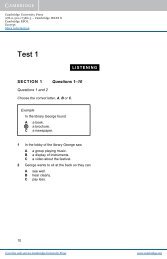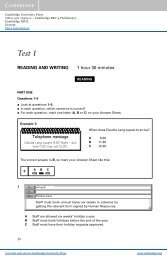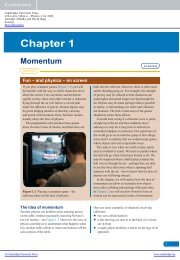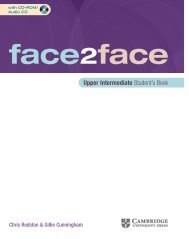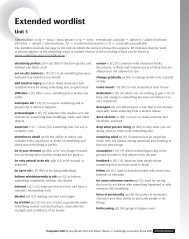Skills for Study Level 2 Teacher's Book - Cambridge University Press
Skills for Study Level 2 Teacher's Book - Cambridge University Press
Skills for Study Level 2 Teacher's Book - Cambridge University Press
Create successful ePaper yourself
Turn your PDF publications into a flip-book with our unique Google optimized e-Paper software.
Part EReporting in writingThe aim of this lesson is <strong>for</strong> students to improve their writing skills through:• using supporting in<strong>for</strong>mation in writing• writing an abstract• avoiding plagiarism.1 Using supporting in<strong>for</strong>mation in writing1aAnswers1 a sentence (or sentences) giving the writer’s main idea, in their own words2 a supporting point or in<strong>for</strong>mation, and citation, from another source3 the writer’s comment on the relevance of the supporting point / in<strong>for</strong>mationParagraph a1Room design features can have an impact on the mood, productivity andcreativity of individuals working and living within the room. This is potentiallysignificant in a range of areas, including work productivity, creative success inthe design industries, and education. Another area in which these findings maybe significant is healthcare. 2 A study by Karlin et al. (2006) found that colourschemes and design features in psychiatric hospitals contributed significantlyto patients’ sense of well-being. 3 There<strong>for</strong>e, it seems reasonable that thoseinvolved in building design should pay attention to so-called ‘affective’ featureswhich influence the people who live and work within them.Paragraph b2Ergonomics, the application of knowledge about the dimensions and movementof the human body, is often associated primarily with health and safety concerns(Dul & Neumann, 2005): 1 researchers have investigated the effects of workpostures, movement, furniture and equipment on injuries at work such as lowerback pain or wrist strain. However, ergonomics also plays a key role in designingbuildings <strong>for</strong> human satisfaction. 2 Pheasant (1986) notes that architects anddesigners who use findings from ergonomics research are better able to designbuildings which are com<strong>for</strong>table and satisfying <strong>for</strong> their occupants.Paragraph c1Student dormitory rooms require careful design, as they are a space <strong>for</strong> bothliving and study. Vital elements include enough light, sensibly designed furniturewhich assists study, and, hopefully, enough peace to be able to concentrate.2However, the student hall of residence must also give a feeling of homecom<strong>for</strong>t (Clemons et al., 2004). 3 This is important not just <strong>for</strong> user satisfaction,but also because it is likely that students who feel ‘at home’ in their residencehave a greater chance of succeeding academically.1bAnswers1 Features in the physical environment can affect creative abilities, problemsolving, work productivity, and mood.2 Natural furnishings, etc. are associated with ‘high’ creativity, and vice-versa in‘unnatural’ rooms.3 This effect can be important in terms of work success, but also in home andschool work.4 There is a link between mood and creativity, though it is not certain exactlywhat mood is best <strong>for</strong> successful creative thought.Unit 4 Part E ∙ Reporting in writing 127






